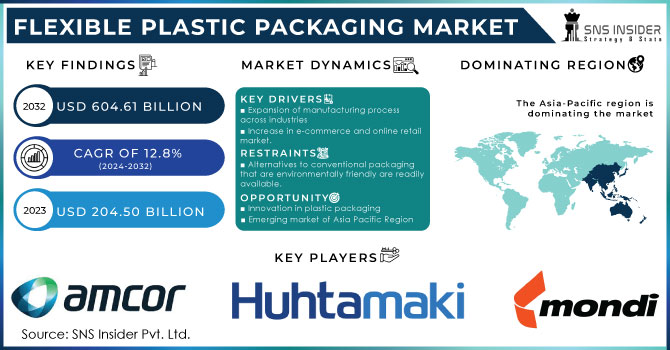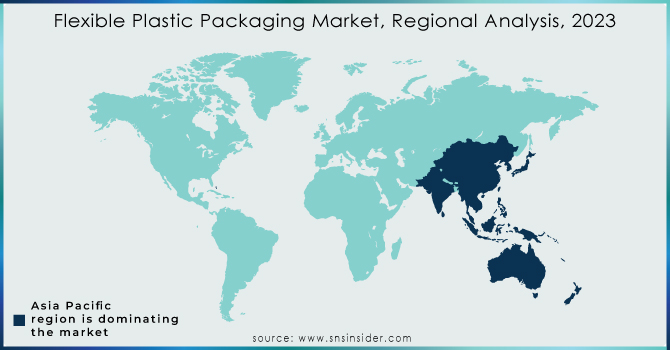Flexible Plastic Packaging Market Key Insights:

Get Sample Copy of Flexible Plastic Packaging Market - Request Sample Report
The Flexible Plastic Packaging Market size was valued at USD 204.50 billion in 2023 and is expected to reach USD 604.61 billion by 2032 and grow at a CAGR of 12.8 % over the forecast period of 2024-2032.
Plastics are organic substances that have a distinct molecular weight and are malleable enough to assume a variety of shapes. They are made of various synthetic organic elements. Plastic typically costs less and performs well. Plastic is a recyclable material that helps the environment by using less energy and producing less waste.
Consumer goods, including everything from food items and electronics to large business machinery and equipment, are widely accepted and allowed to be packaged in plastic. It's a reliable and cost-effective packaging option that many companies use. With the advancement of technology and growing environmental consciousness, the plastic packaging industry has matured.
Plastic packaging has become an essential part of many businesses, due to its innovative design which makes packaging looks more attractive. It also serves as a means of managing brand identity and variation as well as informing customers about the product. Protective plastic packaging is used in the transportation of goods that are challenging to transport.
MARKET DYNAMICS
KEY DRIVERS:
-
Expansion of manufacturing process across industries
The expansion of manufacturing processes in a number of industries, including food and beverage, chemicals, and pharmaceuticals, is a major driver of the plastic packaging market. The market's expansion is being aided by the increase in end-users for packaging solutions, such as the pet-care industry's demand for sustainable plastic packaging. Demand for environmentally friendly, recyclable, and reusable sustainable packaging solutions is rising. Due to the increasing demand for sustainable packaging options, market players have been forced to concentrate on creating new materials and packaging options that meet these requirements.
-
The market will be driven by cost efficiency and extended product shelf life.
-
Increase in e-commerce and online retail market.
RESTRAIN:
-
Alternatives to conventional packaging that are environmentally friendly are readily available.
The growth of the plastic packaging market is observed to be constrained by the availability of environmentally friendly packaging alternatives like paper, metal, and bioplastics. Due to the growing consumer demand for environmentally friendly packaging options, the alternatives are becoming more widely accessible. Sustainable materials are becoming more popular, which is limiting the market's growth for plastic packaging in the packaging sector. Additionally, many companies and industries are emphasizing sustainability in their branding and marketing initiatives to improve the reputation of their brands; this is seen as impeding the expansion of the plastic packaging market.
- Increased cost of raw materials.
OPPORTUNITY:
-
Innovation in plastic packaging
Companies are reorienting their business practices toward circularity and using novel plastic technologies to create sustainable and recyclable products that have specific properties like oxygen, puncture, and chemical resistance, as a result of stringent government regulations, shifting consumer preferences, and environmental pressures.
-
Emerging market of Asia Pacific Region
CHALLENGES:
-
Recycling of Plastic and waste material
There is unavailability of good recycling technology which affects the environment as it can lead to more production of harmful waste and less capacity to recycle the waste material. Polymers have different melting points hence difficult to sort the waste material and recycle it.
-
Breaking the supply chain complexity.
IMPACT OF RUSSIAN UKRAINE WAR
Along with the widespread closure of packaging and production facilities in both Ukraine and Russia, the war has resulted in the departure of over 300 significant Western corporations.
The supply chain for the raw materials used to make flexible plastic packaging was affected by the conflict between Russia and Ukraine. Polyethylene, a crucial component in flexible plastic packaging, is one of the main raw materials exported from Ukraine. Interruptions in the supply of these raw materials resulted in price volatility, scarcity, or the need to find alternative suppliers, which had an impact on the availability and production of flexible plastic packaging.
The conflict may result in heightened border controls, security precautions, and administrative barriers, which affected the import and export of goods, including flexible plastic packaging, in the affected regions.
IMPACT OF COVID-19
The flexible plastic packaging market has not been affected by Covid-19. Plastic has huge demand in all industries, including healthcare, pharmaceuticals, packaging, and many others. Plastic is considered to be safe for health care protection, also it is cost-efficient and lasts longer, and also easy to handle. Plastic had a huge demand in Covid-19 for preparing personal protective equipment. The plastic helps in the spread of diseases and keeps the product safe without spoiling it.
China which is considered to be the leader in the packaging industry lost many of its clients. But this gave rise to the packaging industry in India as businesses were shifting to India.
KEY MARKET SEGMENTATION
By Product Type
-
Pouches
-
Bags
-
Rollstock
-
Films & Wraps
-
Others
By Raw Material
-
Plastic
-
Metal
-
Other
By Printing Technology
-
Rotogravure
-
Flexography
-
Other
By Application
-
Food
-
Beverages
-
Personal Care & Cosmetics
-
Pharmaceutical & Healthcare
-
Others
REGIONAL ANALYSIS
Asia Pacific region holds the largest market share of the global plastic packaging market. This is because of the high consumption of packaged food and growing consumerism, so this region is dominating the global plastic packaging market. The growth of end-user industries of healthcare and pharmaceuticals, and electronics, has also given a boost to the rise of the market in the Asia Pacific region. The high percentage of sales is seen in the Asia Pacific region followed by Europe, and North America.
Europe is an emerging market for plastic packaging products due to the rising demand for sustainable packaging in the pharmaceutical industry. In order to support the market's expansion, there are also cutting-edge technologies for packaging solutions.

Get Customized Report as per Your Business Requirement - Enquiry Now
REGIONAL COVERAGE:
North America
-
USA
-
Canada
-
Mexico
Europe
-
Germany
-
UK
-
France
-
Italy
-
Spain
-
The Netherlands
-
Rest of Europe
Asia-Pacific
-
Japan
-
South Korea
-
China
-
India
-
Australia
-
Rest of Asia-Pacific
The Middle East & Africa
-
Israel
-
UAE
-
South Africa
-
Rest of the Middle East & Africa
Latin America
-
Brazil
-
Argentina
-
Rest of Latin American
Key Players
Some major players in the flexible plastic packaging market are Amcor Ltd, Berry Global Group Inc, Sonoco Products Company, Sealed Air Corporation, DS Smith, Constantia Flexibles, Transcontinental Inc, Mondi Group, Huhtamaki Oyj, Westrock Company, and other players.
RECENT DEVELOPMENTS
-
Amcor to become the first flexible packaging company to offer certified-circular plastics in Australia and New Zealand.
-
With the help of the matching grant, Flexpak UK has developed a recyclable plastic film that is half the thickness of human hair and is extremely thin. The innovative work will lessen the amount of plastic packaging needed to preserve the life of fresh produce and stop single-use plastics from ending up in landfills.
-
The partnership was announced in June 2023 by Ispak Ambalaj, the top flexible packaging company in Turkey, and TIPA Compostable Packaging.
| Report Attributes | Details |
| Market Size in 2023 | US$ 204.50 Bn |
| Market Size by 2032 | US$ 604.61 Bn |
| CAGR | CAGR of 12.8 % From 2024 to 2032 |
| Base Year | 2023 |
| Forecast Period | 2024-2032 |
| Historical Data | 2020-2022 |
| Report Scope & Coverage | Market Size, Segments Analysis, Competitive Landscape, Regional Analysis, DROC & SWOT Analysis, Forecast Outlook |
| Key Segments | • By Product Type (Pouches, Bags, Rollstock, Films & Wraps, Others) • By Raw Material (Plastic, Metal, Other) • By Printing Technology (Rotogravure, Digital Printing, Flexography, Other) • By Application (Food, Beverages, Personal Care & Cosmetics, Pharmaceutical & Healthcare, Others) |
| Regional Analysis/Coverage | North America (USA, Canada, Mexico), Europe (Germany, UK, France, Italy, Spain, Netherlands, Rest of Europe), Asia-Pacific (Japan, South Korea, China, India, Australia, Rest of Asia-Pacific), The Middle East & Africa (Israel, UAE, South Africa, Rest of Middle East & Africa), Latin America (Brazil, Argentina, Rest of Latin America) |
| Company Profiles | Amcor Ltd, Berry Global Group Inc, Sonoco Products Company, Sealed Air Corporation, DS Smith, Constantia Flexibles, Transcontinental Inc, Mondi Group, Huhtamaki Oyj, Westrock Company |
| Key Drivers | • Expansion of manufacturing process across industries |
| Market Opportunities | • Innovation in plastic packaging |

